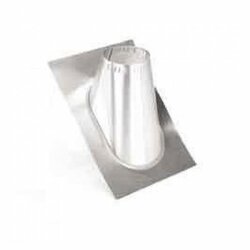I have chimney flashing made for a sloped roof much like thhe one shown in the attachment. The chimney pipe runs thru the flashing, and there is a storm collar immediately above the flashing vent. The collar angles downward (45 degress) and covers the vent when looking at eye level. There is sealant where the collar meets the chimney pipe. The flashing vent is about 3" above the roof line (shingles) at the high point of the sloped roof.
At any rate, my system sometimes leaks. Yesterday I went up on the roof with a hose to localize the problem. When water was applied to the shingles and allowed to flow down to the chimney there was no leaks. When I sprayed all around the flashing base there were no leaks. When I sprayed the chimney pipe above the storm collar there were no leaks. When I sprayed the underside of the storm collar there were massive leaks.
I think the cause of my leak is one of two things.
1. Wind currents on top of the roof is pushing some water upward under the storm collar into the flashing vent.
2. Heavy rain flowing down the roof hits the chimney flashing causing a water dam to form - if the water dam is greater than 3 inches, then water will start to flow into the flashing vent. The distance from the top of the roof down to the chimney is about 15 ' and the slope of the roop is about a 7/12 pitch.
What is the purpose of the flashing vent? Can it be covered up? If so, how should it be covered?
Thanks
Dave
At any rate, my system sometimes leaks. Yesterday I went up on the roof with a hose to localize the problem. When water was applied to the shingles and allowed to flow down to the chimney there was no leaks. When I sprayed all around the flashing base there were no leaks. When I sprayed the chimney pipe above the storm collar there were no leaks. When I sprayed the underside of the storm collar there were massive leaks.
I think the cause of my leak is one of two things.
1. Wind currents on top of the roof is pushing some water upward under the storm collar into the flashing vent.
2. Heavy rain flowing down the roof hits the chimney flashing causing a water dam to form - if the water dam is greater than 3 inches, then water will start to flow into the flashing vent. The distance from the top of the roof down to the chimney is about 15 ' and the slope of the roop is about a 7/12 pitch.
What is the purpose of the flashing vent? Can it be covered up? If so, how should it be covered?
Thanks
Dave


